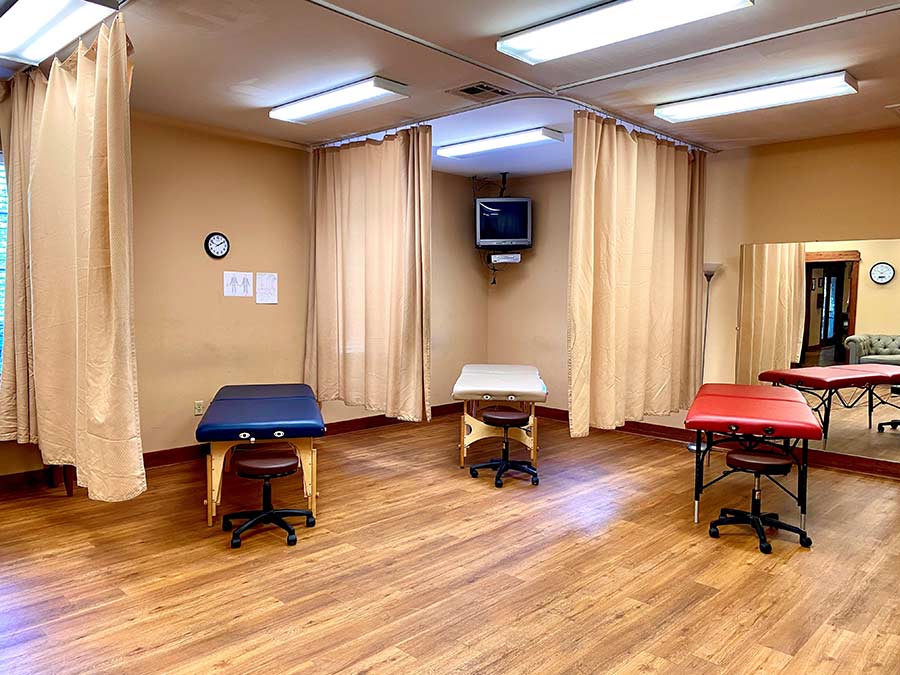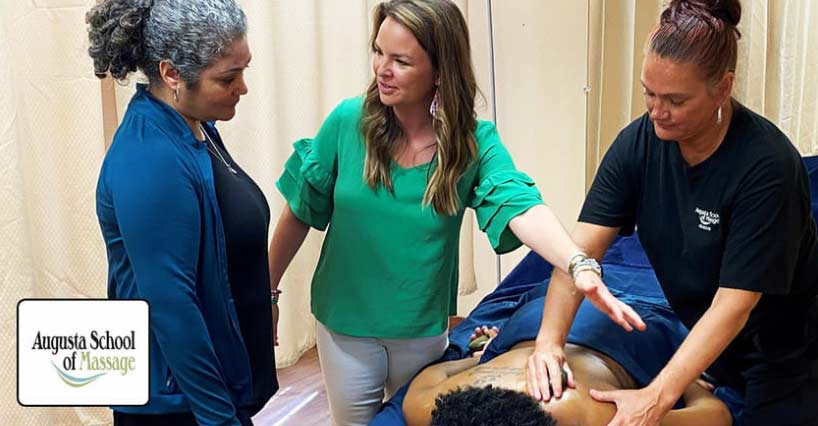Augusta School of Massage
608 Ponder Place Dr.
Evans, GA 30809
Call NOW, to explore your possibilities
706-863-4799
Programs
Programs
The curriculum at Augusta School of Massage is a teaching format that includes intensive massage therapy training as well as business education to prepare the student for success after completion of our program.
Massage Therapy Training
The massage therapy student is educated in several necessary areas, the first of which includes the basics of anatomy, physiology, kinesiology, pathology, and allied modalities. These basics are needed to support the student and lead to a versatile and resourceful massage therapist. The student is also trained in hands-on traditional Swedish massage, which is the basis for a variety of other body therapies. Their training is rounded out with supervised clinics to ensure the student is prepared to take their craft to the public. Graduates will also be educated in AIDS/HIV awareness.
Business Education
An important focus for students preparing for a career in massage therapy is the business aspect of the profession. Augusta School of Massage will provide students with essential information to help them smoothly transfer from student to professional massage therapist, whether they plan to open their own practice, become an independent contractor, or work as an employee in a medical facility, spa, fitness club, or another health-related setting.
After completing the course with a satisfactory grade and meeting all other requirements, Augusta School of Massage provides the student with a certificate of completion. This certificate enables them to take the Massage and Bodywork Licensing Exam (MBLEx).
Both Georgia and South Carolina accept the MBLEx. Other states’ requirements may vary.
Course Schedule
Day Classes – Monday through Thursday: 8:30 a.m. to 1:00 p.m.
Evening Classes – Monday through Thursday: 6:00 p.m. to 10:30 p.m.
In addition to the week-day classes you are also required to attend an all-day class on a Friday or Saturday approximately one to two times a month and complete 65 clinic massages.
For completion, 600 total clock hours are required, leading to approximately 25 weeks of study (6 months). “Clock hours” can be described as instruction that takes place for at least 50 minutes of each hour. Teachers will have no more than 35 students per class. For classes involving hands-on instruction, the ratio will be no more than 15 students for each instructor. Students will receive no more than 10 minutes of break time each hour. No breaks for noon and evening meals are scheduled.
Curriculum – 600 Clock Hours
Massage Therapy Theory and Practice – 185 Clock Hours
The basics of massage therapy are studied in this course, consisting of lecturing and hands-on methods of learning. In lecturing, the primary massage therapy technique, Swedish massage therapy, and variations thereof are taught, along with fundamental practices such as draping, oils, and creams currently being used by professional massage therapists, contraindications, and professional and appropriate body mechanics. Along with learning the necessary therapy procedures, students will spend course hours practicing therapeutic and healing massages using the techniques studied. Teachers will use this time to evaluate the students’ techniques and help them enhance their ability to heal through massage. Since the therapist/client relationship involves more than just massage therapy – interviewing, listening and observation skills will be taught to enhance the relationship the therapist has with his or her client.
Included in Massage Therapy Theory and Practice are Hydrotherapy and Spa Treatments
This course discusses the many benefits of water as a therapeutic tool in massage therapy and rehabilitation. The student will learn the history, philosophy and culture of the spa experience and will be introduced to various spa treatments, including hot stone massage, using water through ice packs, heat packs, saunas and steam baths are studied, as well as the use of contrast applications, paraffin dips, salt glows, and herbal wraps.
Massage Clinic – 65 Clock Hours
During the clinical experience the student will be closely monitored by the instructing staff. This will be an interactive learning experience among the practice clients, student practitioners, and the instructing staff. The clients will be made aware that the students are involved in an active learning experience and that constructive feedback is important in order for the student to continue to integrate and improve their skills. They will also be made aware that the instructing staff will be interacting with the student during the massage sessions, providing correction, suggestion and reinforcement. Students will be asked to be open to feedback, able to learn with tableside instruction, open to correction without becoming embarrassed or defiant, and engage the client in an active learning experience. Once a student has completed their Hot Stone Class they will be eligible to perform one hour hot stone massages in the Student Massage Clinic. Students will be responsible for the set up and clean up of the stones. Each one hour hot stone massage will count as one massage of the 65 required massage hours. Once a student has completed prenatal class they can take prenatal clients in regular student clinic.
Business & Ethics (Includes History and Law) – 20 Clock Hours
Students are taught valuable business skills including how to market their services. The history of massage therapy is also discussed in this course, along with the importance of ethics in a professional practice. National, state and county laws governing Georgia and surrounding states are discussed to prepare the student to have good business practices. During this course, business-related issues are discussed, giving the student information that is necessary to starting their journey as a massage therapist.
Anatomy, Physiology, and Kinesiology – 145 Hours
This course in anatomy, physiology and kinesiology teaches students the major body systems and functions and focuses primarily on the skeletal and muscular systems. Medical terminology is learned in order to ensure that the student can easily communicate with other healthcare professionals. The student also learns detailed information about the body’s intricate muscular and skeletal systems, body movement, and how muscle pain affect basic, normal, and important functions of the body. Muscular and skeletal anatomy is explored in a deeper and more creative way through anatomy with Manikens™, as students use clay to build muscles onto models of the human skeleton. This will assist the student in retaining primary information necessary for becoming a skilled massage therapist. Anatomy, physiology, and kinesiology also includes more detailed body systems and how those systems relate to massage therapy. The immune system, nervous system, and endocrine system are studied in depth, with focus on pain and nerve impulses and pathways, the function and make-up of the brain and how it interacts with the nervous system and endocrine gland function. The body’s emotional system is also explored, examining stress and relaxation and how it relates to brain and body function.
Clinical Pathology and Contraindications – 60 Clock Hours
The importance of learning contraindications in massage therapy cannot be understated. In this course, contraindications and pathology are studied in relation to the massage therapist’s role in the overall health and well-being of his or her client. Understanding symptoms of pathology is important in order to avoid complications of the client’s condition and keep them from further health risk. The massage therapist professional must know when to refer their client to other health care professionals in place of, or in addition to, massage therapy care.
Also Included in Clinical Pathology and Contraindications is 4.5 Clock Hours of AIDS/HIV Education
AIDS and HIV are studied for two reasons in this short course. One, the student must have a clear knowledge of how AIDS/HIV is spread in order to avoid unnecessary fears and yet safely treat the HIV infected patient. Secondly, the student learns up-to-date information on the advantages of massage therapy for the HIV infected person.
Allied Modalities – 125 Clock Hours
Techniques and procedures of massage therapy are studied in allied modalities. Areas of study include clinical and orthopedic massage, myofascial release, neuromuscular therapy, and postural analysis. The following is a description of just a few of our allied modality classes: Myofascial release is a deep, slow-moving technique that seeks to improve the body’s alignment through the release of fascia (connective tissue) and improved flexibility. Neuromuscular therapy is a technique that palpates muscle, affects the level of resting tension of muscles and has additional psychoneuroimmunological effects. Students also receive an introduction to reflexology, infant and prenatal massage.


